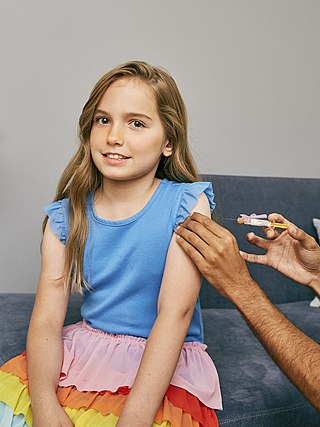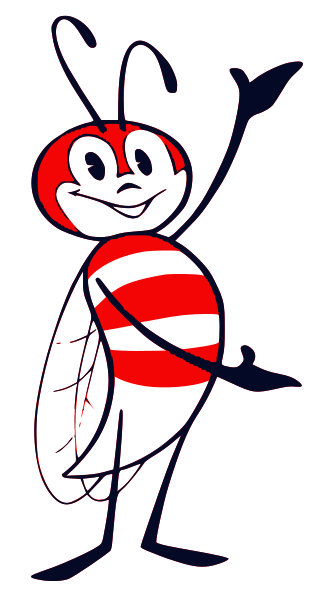Related Research Articles

Edward Jenner was an English physician and scientist who pioneered the concept of vaccines and created the smallpox vaccine, the world's first vaccine. The terms vaccine and vaccination are derived from Variolae vaccinae, the term devised by Jenner to denote cowpox. He used it in 1798 in the title of his Inquiry into the Variolae vaccinae known as the Cow Pox, in which he described the protective effect of cowpox against smallpox.

Vaccination is the administration of a vaccine to help the immune system develop immunity from a disease. Vaccines contain a microorganism or virus in a weakened, live or killed state, or proteins or toxins from the organism. In stimulating the body's adaptive immunity, they help prevent sickness from an infectious disease. When a sufficiently large percentage of a population has been vaccinated, herd immunity results. Herd immunity protects those who may be immunocompromised and cannot get a vaccine because even a weakened version would harm them. The effectiveness of vaccination has been widely studied and verified. Vaccination is the most effective method of preventing infectious diseases; widespread immunity due to vaccination is largely responsible for the worldwide eradication of smallpox and the elimination of diseases such as polio and tetanus from much of the world. However, some diseases, such as measles outbreaks in America, have seen rising cases due to relatively low vaccination rates in the 2010s – attributed, in part, to vaccine hesitancy. According to the World Health Organization, vaccination prevents 3.5–5 million deaths per year.

Polio vaccines are vaccines used to prevent poliomyelitis (polio). Two types are used: an inactivated poliovirus given by injection (IPV) and a weakened poliovirus given by mouth (OPV). The World Health Organization (WHO) recommends all children be fully vaccinated against polio. The two vaccines have eliminated polio from most of the world, and reduced the number of cases reported each year from an estimated 350,000 in 1988 to 33 in 2018.

The UC Berkeley Graduate School of Journalism is a graduate professional school on the campus of University of California, Berkeley. It is designed to produce journalists with a two-year Master of Journalism (MJ) degree. It also offers a summer minor in journalism to undergraduates and a journalism certificate option to non–UC Berkeley students.

Donald Ainslie Henderson was an American medical doctor, educator, and epidemiologist who directed a 10-year international effort (1967–1977) that eradicated smallpox throughout the world and launched international childhood vaccination programs. From 1977 to 1990, he was Dean of the Johns Hopkins School of Public Health. Later, he played a leading role in instigating national programs for public health preparedness and response following biological attacks and national disasters. At the time of his death, he was Professor and Dean Emeritus of the Johns Hopkins Bloomberg School of Public Health, and Professor of Medicine and Public Health at the University of Pittsburgh, as well as Distinguished Scholar at the UPMC Center for Health Security.

Vaccine hesitancy is a delay in acceptance, or refusal, of vaccines despite the availability of vaccine services and supporting evidence. The term covers refusals to vaccinate, delaying vaccines, accepting vaccines but remaining uncertain about their use, or using certain vaccines but not others. Although adverse effects associated with vaccines are occasionally observed, the scientific consensus that vaccines are generally safe and effective is overwhelming. Vaccine hesitancy often results in disease outbreaks and deaths from vaccine-preventable diseases. Therefore, the World Health Organization characterizes vaccine hesitancy as one of the top ten global health threats.
A vaccine adverse event (VAE), sometimes referred to as a vaccine injury, is an adverse event believed to have been caused by vaccination. The World Health Organization (WHO) knows VAEs as Adverse Events Following Immunization (AEFI).

Paul D. Thacker is an American journalist who reports on science, medicine, and the environment. He was a lead investigator of the United States Senate Committee on Finance for Senator Chuck Grassley, where he examined financial links between physicians and pharmaceutical companies.

Hepatitis B vaccine is a vaccine that prevents hepatitis B. The first dose is recommended within 24 hours of birth with either two or three more doses given after that. This includes those with poor immune function such as from HIV/AIDS and those born premature. It is also recommended that health-care workers be vaccinated. In healthy people, routine immunization results in more than 95% of people being protected.
Claims of a link between the MMR vaccine and autism have been extensively investigated and found to be false. The link was first suggested in the early 1990s and came to public notice largely as a result of the 1998 Lancet MMR autism fraud, characterised as "perhaps the most damaging medical hoax of the last 100 years". The fraudulent research paper, authored by discredited former doctor Andrew Wakefield and published in The Lancet, falsely claimed the vaccine was linked to colitis and autism spectrum disorders. The paper was retracted in 2010 but is still cited by anti-vaccine activists.
A vaccination policy is a health policy adopted in order to prevent the spread of infectious disease. These policies are generally put into place by state or local governments, but may also be set by private facilities, such as workplaces or schools. Many policies have been developed and implemented since vaccines were first made widely available.

Yellow fever vaccine is a vaccine that protects against yellow fever. Yellow fever is a viral infection that occurs in Africa and South America. Most people begin to develop immunity within ten days of vaccination and 99% are protected within one month, and this appears to be lifelong. The vaccine can be used to control outbreaks of disease. It is given either by injection into a muscle or just under the skin.
Walter A. Orenstein served as the director of the United States' National Immunization Program, from May 1993 to January 2004.

Dorit Rubinstein Reiss is a Professor of Law and the James Edgar Hervey '50 Chair of Litigation at UC Hastings College of Law. She has also worked for the Hebrew University of Jerusalem and the Israeli Ministry of Justice's Department of Public Law.
Anti-vaccinationism in chiropractic is widespread, but there are notable differences within the trade. Chiropractic is a form of alternative medicine founded on the idea that all disease is caused by disruption of the flow of "innate" in the spine, by so-called vertebral subluxations – a pseudoscientific concept. Over time chiropractic has divided into "straights" who adhere to the subluxation theory and "mixers" who adhere more closely to a reality-based view of anatomy. "Straight" chiropractors are very likely to be anti-vaccination, but all chiropractic training tends to reduce acceptance of vaccines.

Vaccination policy of the United States is the subset of U.S. federal health policy that deals with immunization against infectious disease. It is decided at various levels of the government, including the individual states. This policy has been developed over the approximately two centuries since the invention of vaccination with the purpose of eradicating disease from the U.S. population, or creating a herd immunity. Policies intended to encourage vaccination impact numerous areas of law, including regulation of vaccine safety, funding of vaccination programs, vaccine mandates, adverse event reporting requirements, and compensation for injuries asserted to be associated with vaccination.

Shabir Ahmed Madhi, is a South African physician who is professor of vaccinology and director of the South African Medical Research Council Respiratory and Meningeal Pathogens Research Unit at the University of the Witwatersrand, and National Research Foundation/Department of Science and Technology Research Chair in Vaccine Preventable Diseases. In January 2021, he was appointed Dean of the Faculty of Health Sciences at the University of the Witwatersrand.

Wellbee was an American cartoon character and public health mascot that first appeared in 1962. He was an anthropomorphic bumblebee created by Hollywood artist Harold M. Walker at the request of Centers for Disease Control and Prevention's (CDC) public information officer George M. Stenhouse. The character became CDC's national symbol of public health at the time, and was widely used to promote immunization and other public health campaigns in the United States following the Vaccination Assistance Act of 1962.

War Against Smallpox: Edward Jenner and the Global Spread of Vaccination is a 2020 book by historian and academic Michael J. Bennett. It describes "the devastating and disfiguring impact of smallpox still at large "in the shrinking eighteenth-century globe." It shows how increasing recourse to smallpox inoculation, a risky procedure, prompted Edward Jenner's early experimentation with cowpox as a prophylaxis for smallpox.
References
- 1 2 3 4 5 "Elena Conis". UC Berkeley Graduate School of Journalism. Berkeley Journalism. Retrieved 22 January 2021.
- ↑ "Bookshelf". Columbia College Today. Summer 2015. Archived from the original on 2016-09-16. Retrieved August 8, 2021.
- ↑ Kuhn, Mary Ellen (August 1, 2011). "At The Forefront of Food Science". Food Technology Magazine. 65 (8). Retrieved 22 January 2021.
- ↑ Williams, Kimber (April 1, 2014). "Elena Conis: Bridging health history and the humanities". Emory Report. Emory News Center. Retrieved 22 January 2021.
- ↑ "Elena Conis". Science History Institute. Retrieved 22 January 2021.
- ↑ Morrison, Patt (28 January 2015). "Column: Historian Elena Conis takes a look at decades of vaccination skepticism". Los Angeles Times. Retrieved 22 January 2021.
- ↑ "The Points Interview: Elena Conis". Points: Joint Blog of the Alcohol & Drugs History Society and the American Institute of the History of Pharmacy. Points. Retrieved 22 January 2021.
- ↑ "MJ/MPH with the Graduate School of Journalism". Berkeley Public Health. Retrieved 22 January 2021.
- ↑ "Faculty & Fellows". University of California, Berkeley, Center for Science, Technology, Medicine & Society. 21 December 2016. Retrieved 22 January 2021.
- ↑ "People". Berkeley Center for Social Medicine. Retrieved 22 January 2021.
- ↑ "Affiliated Faculty". University of California, Berkeley, Media Studies. Retrieved 22 January 2021.
- ↑ "Faculty". University of California, San Francisco, Department of Humanities and Social Sciences. Retrieved 22 January 2021.
- ↑ Gobo, Giampietro (June 2020). "A cumulative book review of: Conis, E.Vaccine Nation: America's Changing Relationship with Immunization, Chicago: University of Chicago Press2015. 361 pp $18 (pbk) $18 (ebk) ISBN 978-0-22637839-8 Reich, J.A.Calling the Shots: Why Parents Reject Vaccines, New York: New York University Press2016. 336 pp $75 (cloth) $20.00 (pbk) ISBN 978-1-47981279-0 Holmberg, C., Blume, S. and Greenough, P.R. (eds) The Politics of Vaccination: A Global History, Manchester: Manchester University Press2017. 360 pp £96 (cloth) £96 (ebk) ISBN 978-1-5261-1088-6". Sociology of Health & Illness. 42 (5): 1220–1223. doi: 10.1111/1467-9566.13046 . hdl: 2434/738621 .
- ↑ Davidovitch, Nadav (2016). "Vaccine Nation: America's Changing Relationship with Immunization by Elena Conis". Bulletin of the History of Medicine. 90 (4): 748–750. doi:10.1353/bhm.2016.0133. S2CID 79203341 . Retrieved 26 January 2021.
- ↑ "Review of Elena Conis, "Vaccine Nation: America's Changing Relationship with Vaccination" | Inside Higher Ed". www.insidehighered.com.
- ↑ "Vaccine Nation: America's Changing Relationship with Immunization, by Elena Conis". Times Higher Education (THE). 27 November 2014. Retrieved 26 January 2021.